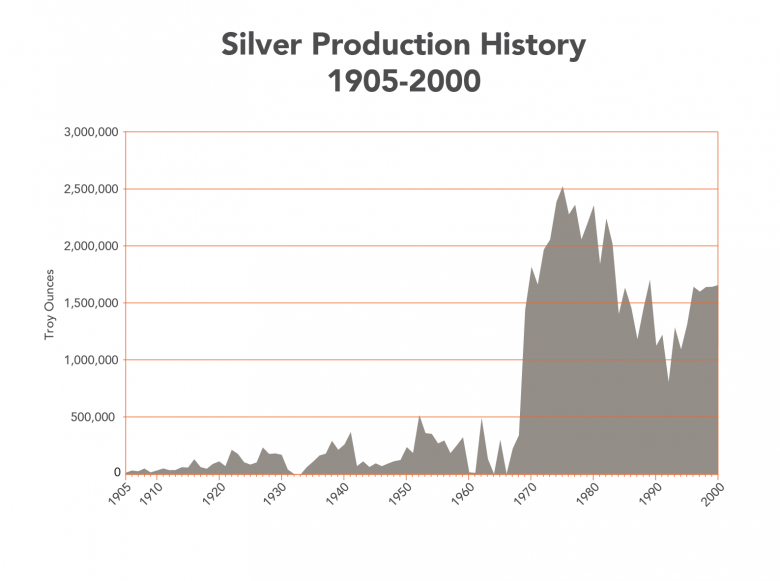
Commodity

Silver is a highly ductile, malleable, reflective and electrically conductive metal. In Missouri, silver currently is produced as a byproduct of lead and zinc mining, where it is contained in the crystal lattice of sphalerite (ZnS). In the past, it has been produced from argentiferous galena (PbS) - galena, which contains silver and its crystal structure. There are no silver-dominant minerals mined in Missouri.
Silver is from the Old English "seolfor." Known by the Romans as "argentum," this provided the source for the chemical symbol "Ag" and is the root of "argentiferous," a modifier used to denote a silver-containing but not silver-dominant mineral, such as argentiferous galena.
Economic Importance
Missouri is one of 11 states that produces silver (Bennett, 2020). Total, all-time Missouri silver production is estimated at more than 93 million troy ounces, valued at more than $1.4 billion in 2018 prices.
Silver in Minerals in Missouri
No primary silver or silver-dominant minerals are commonly found in Missouri. Silver is contained in the crystal structure of both galena (PbS, see lead information) and sphalerite (ZnS, see zinc information).
Primary Uses
Silver has a multitude of uses. These include electronics, coins, jewelry, silverware and photography. Due to its antimicrobial properties, it is a critical component of medical bandages, clothing, pharmaceuticals and plastics, and is a key element in burn treatment. It is also used in solar cells, water purification, wood treatment, catalytic converters and many other items.
Past Uses
Silver was known for its antimicrobial properties in ancient times and is described in writings by the ancient Greeks, Egyptians, Romans and Chinese. From ancient times to the settlement of the American West, silver as nuggets or coins was put in water, milk, wine and other liquids to prevent spoilage and limit bacterial and microbe growth. During World War I, it was used to prevent and cure infection in combat-related wounds and during surgical care.
Principal Locations of Silver in Missouri

While silver may occur with lead or zinc minerals found throughout large parts of Missouri, the majority of silver producers or noted occurrences are found in several areas of the southern part of the state.
Silver Mines Area, Madison County
- The only area mined specifically for silver, along with tungsten.
- Area was worked sporadically but was never highly productive.
- Mines are a series of small underground workings and shallow surface mines.
Southeast Missouri Lead District
- Comprises several subdistricts.
- The Old Lead Belt (1700s to 1972, St. Francois County), and Mine LaMotte-Fredericktown (1720-1961, Madison and St. Francois counties) produced or were known to contain silver.
- The Viburnum Trend (1955 to present) continues to produce silver as a byproduct.
- The Viburnum Trend underlies the counties of Crawford, Dent, Iron, Reynolds and Washington.
Tri-State District
- So-called as it covered portions of southwest Missouri, northeast Oklahoma and southeast Kansas.
- Tri-State zinc and lead concentrates from Missouri are known to have contained minor amounts of silver.
Geologic Occurrence
Silver in the Silver Mines area of Madison County is found in argentiferous galena. The galena is contained in quartz veins that cut Precambrian granite exposed in hillsides along the St. Francois River. The site is host to a variety of minerals that are otherwise uncommon in Missouri.
Silver also is found in zinc- and lead-bearing minerals primarily hosted by Cambrian- through Mississippian-age sedimentary rocks in southern Missouri. Host rocks are primarily limestone and dolomite, although the ores are sometimes found in sandstone and jasperoid. The silver-bearing zinc and lead minerals are found as crystals in open spaces in the rocks, fine grains scattered through the rock, filling fractures in host rocks, or filling spaces between sand grains.
Mining

Silver, as a byproduct of lead and zinc mining, is mined at depths as great as 1,400 feet in the mines in the Viburnum Trend. This mining is currently entirely by underground methods. Ores are crushed, transported to the surface, crushed further, and run through flotation cells to separate the metal ores from the dolomite or limestone and other ore and non-ore minerals. Ores are then smelted to generate silver metal. Early mining was often by hand in pits or in shallow shafts in both the Southeast Missouri Lead District and in the Silver Mines area.
Production History
Silver production in Missouri from 1905-2000. Data for later years not available. The increase near 1970 marks increased production from the Viburnum Trend.
References
Bennett, S.M., 2020, Silver; in 2016 Minerals Yearbook, U.S. Geological Survey, p. 68.1-68.13
Additional Resources
Historic maps of mines are available in our Mine Map Repository.
Visit the department’s Ed Clark Museum of Missouri Geology, where zinc, lead and other minerals are on display.

